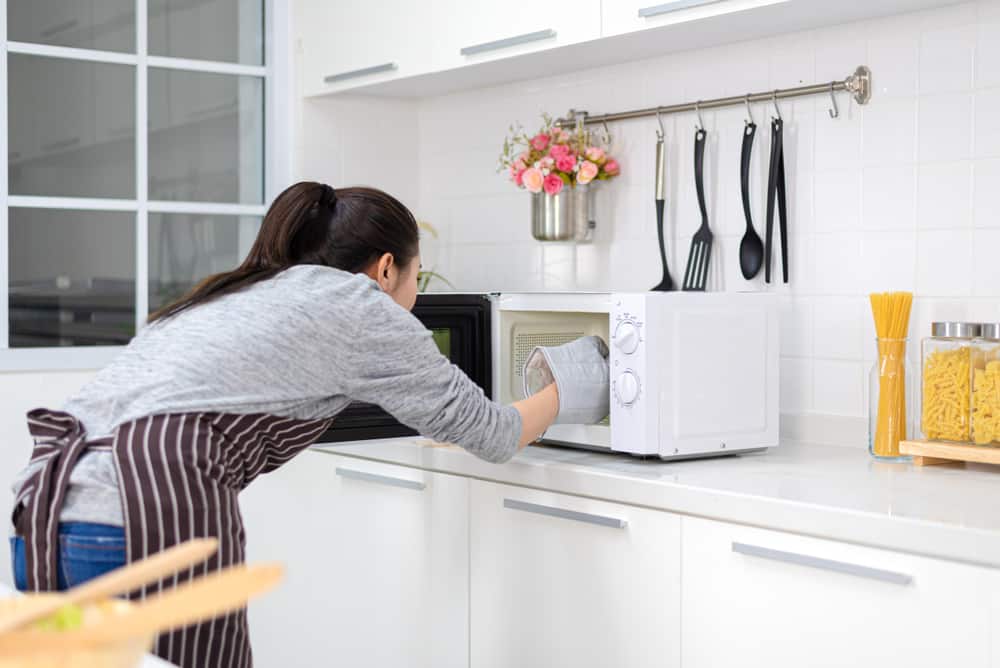
You may have noticed recently that your green beans (or other vegetables) make sparks in the microwave when you try to cook them. This can be alarming so we set out to investigate the cause. Is it caused by a fault in the microwave or is it the beans themselves?
Why Do Green Beans Spark in The Microwave?
- Green Beans Contain Metal Ions and Minerals
Green beans are one of the nutrient-dense vegetables just like carrots, spinach, kale, and green peppers that contain large amounts of metal ions and minerals in them compared to other foods.
Minerals such as iron and magnesium in your greens can behave as metal pieces and create a firework display in your microwave while heating up.
This process of spark happens because of the ‘Arcing Effect’ that happens when heating metal pieces in the microwave. These sparks occur because of the reflection of electromagnetic waves in the microwave.
- Electric Fields Causing the Effect
These sparks are not just happening because of the metals present in your green beans because there are not enough of them to create the arcing effect.
This occurs when the microwave creates electromagnetic waves that go through the vegetables, vibrating the water particles inside them. This is what heats the food up.
These electric fields set up by the microwave can vary in different areas of the microwave. They become enhanced when they interact with any small piece of metal and the field gets stronger in the surrounding air.
To understand this, you can cut some green bean pieces evenly and put them into the microwave. Now, each piece of green bean will develop individual charges and those pieces will cause a spark that has metal particles.
It is similar to the static charge you get when touching objects like a doorknob. This shows that your vegetables do not need a high amount of metal ions to create a spark and only a few particles can create a difference in the electric field.
However, if you try heating the same vegetable that is mixed into a sauce or gravy, the sparking will not occur as it will not generate the electric field around in the same way because of being covered with the sauce. It’s like putting a fire out with water.
No Metal Inside, Please!
On the US Department of Agriculture’s microwave safety page, it warns that some foods such as carrots or hot dog sausages can arc in the microwave.
It is the same thing that occurs if you accidentally leave a teaspoon inside the mug of coffee you want to reheat or use a dish with a metal edge. You may be seeing a pattern here…it’s often the long pointy things (green beans included) that cause sparks.
Plants require iron just as we do to function. They use it, for example, for photosynthesis and to make chlorophyll. Dark leafy greens contain a lot of iron, which is why you may get sparks if you try to make kale chips in your microwave.
However, just containing metals isn’t enough to create a charge. The shape has to be right. For instance, a sheet of flat metal put into the microwave probably won’t arc. It takes a specific geometry (shape) to enhance the fields, which is why sometimes your beans will spark and sometimes they won’t.
Microwaves have two types of fields – electrical and magnetic. The electrical fields do the heating and cooking. If there’s a small piece of metal (or ions in the veg) in the cooker, it can enhance the electrical field locally.
It’s comparable to the lightning rod on your home. The rod consists of conductive metal with a pointy end so it creates a stronger electric field than the air surrounding it.
In short, there doesn’t have to be a lot of metal to create a spark. There just needs to be a difference in the electric properties from one area to another such as from a piece of bean containing metal to the air.
Having a lot of sharp edges enhances the effect. So, the sparks on your green beans are a kind of mini lightning bolt. Benjamin Franklin would have loved that!
How to Stop Your Beans From Sparking
Cook your beans in a small amount of water rather than dry. This will ensure that no sparks can form.
Best Way to Microwave Green Beans
- Trim the tops and tails off your beans. Keep them whole or cut them up. The important thing is to keep the beans in even sizes to ensure uniform cooking.
- Put the beans into a microwave-safe dish.
- Cover them with water and add a pinch of salt.
- Cover them with a microwave-safe lid or plastic wrap (this will ensure that they steam evenly).
- Cook on High for 5-6 minutes until the beans are bright green and crisply tender.
- Allow the beans to stand for a minute or two to finish cooking.
- Drain and toss in a little garlic butter, salt, and pepper.
Is Sparking in a Microwave Dangerous?
Most of the time, if your microwave sparks, you are safe. Always turn it off at once as sparks can permanently damage your microwave inside. Remove the offending piece of metal from the appliance. If it’s vegetables, add a little water and a microwave-safe lid.
The only time a sparking microwave is dangerous is when there’s an electrical issue and the electronics are broken. If you are unsure, unplug the appliance and have it checked by a technician.
Conclusion
Your microwave sparking due to the ions in green beans is not dangerous. Simply cover the beans with a little water and a lid and continue to cook them. We hope this sets your mind at rest.



